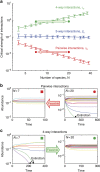High-order species interactions shape ecosystem diversity
- PMID: 27481625
- PMCID: PMC4974637
- DOI: 10.1038/ncomms12285
High-order species interactions shape ecosystem diversity
Abstract
Classical theory shows that large communities are destabilized by random interactions among species pairs, creating an upper bound on ecosystem diversity. However, species interactions often occur in high-order combinations, whereby the interaction between two species is modulated by one or more other species. Here, by simulating the dynamics of communities with random interactions, we find that the classical relationship between diversity and stability is inverted for high-order interactions. More specifically, while a community becomes more sensitive to pairwise interactions as its number of species increases, its sensitivity to three-way interactions remains unchanged, and its sensitivity to four-way interactions actually decreases. Therefore, while pairwise interactions lead to sensitivity to the addition of species, four-way interactions lead to sensitivity to species removal, and their combination creates both a lower and an upper bound on the number of species. These findings highlight the importance of high-order species interactions in determining the diversity of natural ecosystems.
Figures




References
-
- Hutchinson G. E. The paradox of the plankton. Am. Nat. 95, 137–145 (1961).
-
- Rosenzweig M. L. Species Diversity in Space and Time Cambridge University Press (1995).
-
- Paine R. T. Food web complexity and species diversity. Am. Nat. 100, 65–75 (1966).
-
- Ives A. R. & Carpenter S. R. Stability and diversity of ecosystems. Science 317, 58–62 (2007). - PubMed
Publication types
MeSH terms
Grants and funding
LinkOut - more resources
Full Text Sources
Other Literature Sources

